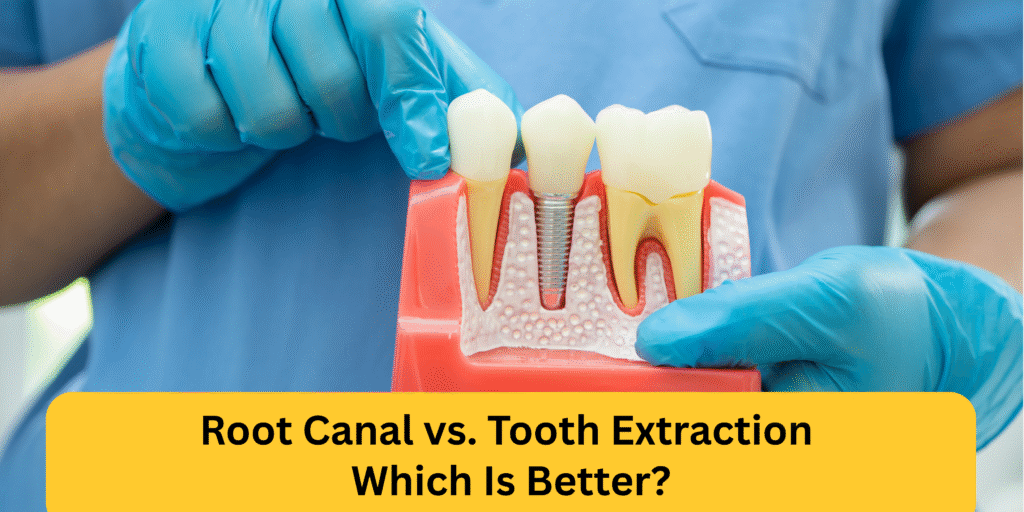When a tooth becomes severely damaged or infected, two common dental treatments are usually considered: root canal treatment (RCT) or tooth extraction. Both procedures aim to relieve pain and prevent further oral health issues, but they differ greatly in approach, recovery, cost, and long-term results.
If you’ve ever wondered whether it’s better to save your tooth or remove it, this guide will help you understand the key differences between root canal treatment and tooth extraction, so you can make an informed decision with your dentist.
🔹 What Is a Root Canal?
A root canal treatment is a procedure used to save a tooth that has deep decay, infection, or damage to the pulp (the soft tissue inside the tooth containing nerves and blood vessels). During RCT:
The dentist removes the infected pulp.
The root canals are cleaned, disinfected, and sealed.
A crown is usually placed on the treated tooth for protection.
👉 Goal: Save your natural tooth and restore its function.
🔹 What Is a Tooth Extraction?
Tooth extraction is the complete removal of a tooth from its socket in the jawbone. Extractions are recommended when:
The tooth is too damaged to be restored.
Severe infection or bone loss has occurred.
Wisdom teeth are impacted or problematic.
After extraction, the missing tooth can be replaced with options like a dental implant, bridge, or denture.
👉 Goal: Remove the source of infection or damage when saving the tooth isn’t possible.
⚖️ Root Canal vs. Tooth Extraction: Key Differences
- Pain and Discomfort
Root Canal: Modern root canal procedures are virtually painless, thanks to local anesthesia. Some mild soreness may follow, but it’s manageable with medication.
Extraction: The procedure is quick and also performed under anesthesia, but recovery often involves more discomfort, swelling, and longer healing time.
- Preservation of Natural Teeth
Root Canal: Keeps your natural tooth in place, maintaining chewing ability and jawbone health.
Extraction: Removes the tooth entirely, which may cause shifting of surrounding teeth and bite problems if not replaced.
- Long-Term Oral Health
Root Canal: Prevents tooth loss, preserves natural bite, and reduces the risk of jawbone deterioration.
Extraction: If the gap isn’t restored with an implant or bridge, bone loss and misalignment of nearby teeth may occur over time.
- Treatment Duration
Root Canal: May require 1–2 visits depending on the case, followed by crown placement.
Extraction: Usually completed in a single visit, though healing and tooth replacement may take longer.
- Cost Factor
Root Canal: Higher upfront cost than extraction but more cost-effective in the long run, since it avoids the need for replacement options.
Extraction: Lower initial cost but may lead to additional expenses for implants, bridges, or dentures to restore function and aesthetics.
- Risks and Complications
Root Canal: If not done properly, infection may recur, but success rates are high (over 90%).
Extraction: Risks include dry socket, infection, and shifting teeth if replacements are delayed.
✅ When Is Root Canal Better?
Tooth structure is restorable.
You want to keep your natural tooth.
The infection is localized and can be removed.
You want to maintain proper chewing and jaw function.
✅ When Is Extraction Better?
Tooth is severely decayed or fractured beyond repair.
Gum disease has caused extreme bone loss.
Wisdom tooth problems (impaction, repeated infection).
Budget or medical conditions don’t allow for root canal.
🦷 Which Is Better: Root Canal or Extraction?
The answer depends on your specific dental condition:
If the tooth can be saved → Root canal is usually the better option. It maintains your natural tooth, bite, and smile while reducing long-term risks.
If the tooth is beyond repair → Extraction is necessary. However, replacing the missing tooth with an implant or bridge is strongly recommended to prevent future oral health issues.
Final Thoughts
When it comes to root canal vs. extraction, saving your natural tooth with a root canal is generally the preferred option whenever possible. Modern dentistry has made root canals comfortable, safe, and long-lasting. Extractions are necessary only when the damage is too extensive.
Ultimately, the decision should be made after a professional dental evaluation. Your dentist will consider the condition of your tooth, overall oral health, and future needs before recommending the best treatment.
👉 Remember: A healthy, natural smile is always worth preserving whenever possible.

